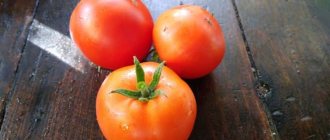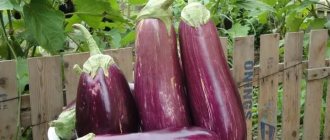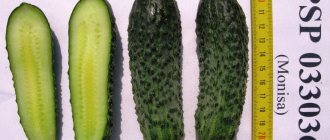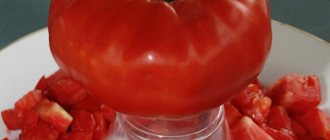The Taimyr tomato is an ultra-early ripening variety bred by Russian breeders for regions with cold climates. Designed for cultivation in open ground and film shelters. The plant tolerates spring and summer cold snaps well, recovers quickly and continues to bear fruit, and the fruit harvest period lasts until the first frost, which is especially pleasing to fans of fresh vegetables.
Tomato seeds of the “Taimyr” variety
Tomato variety “Taimyr”
Taimyr bushes are massive and low-growing
Description of the variety
Taimyr is resistant to low temperatures, so it continues to grow and bear fruit even during spring frosts. The first harvest can be obtained 75-90 days after emergence. More details on the characteristics of bushes and fruits can be found below.
Bushes
The plant is determinate, standard and compact. The bushes are strong and low-growing - they grow up to 25-45 cm. The root system is well developed and penetrates deep into the soil, where it is reliably protected from low temperatures. The crown is sparse and formed by large dark green vesicular leaves. Thanks to this shape, good lighting and ventilation of ripe fruits is provided.
By the end of June, a large number of ovaries appear on the tops, which are compactly collected in brushes. Often, when grown in open ground, 4-5 simple clusters are formed simultaneously on one plant. Each of them can contain up to 5-8 fruits.
The plant develops well under conditions of temperature changes and spring frosts, since it is cold-resistant. So, after bad weather, it quickly restores growth and rapidly increases the yield.
Fruit
Their mass setting in the North-West occurs from the end of June, and ripe tomatoes appear in mid-July. Fully ripened fruits have a bright red hue, a round shape, dense and sugary pulp, weighing up to 80-100 g. The taste of the tomato is pronounced, sweet and with a pleasant sourness.
The purpose of the tomato is universal. It is advisable to consume the first harvest raw, serving it as slices or in salads. As the fruits ripen, they can be salted in barrels and preserved. They have a thick skin, so they do not crack after heat treatment, and due to their small size they can easily fit into a jar.
Characteristics table
The main qualities of the variety are described in the table:
| Parameter | Description |
| Growing method | In open ground, greenhouse, greenhouse, under film cover |
| Cultivation region | Ideal for cultivation in northern regions, as it is adapted to the local climate. In regions with a milder climate, it is worth choosing varieties with less resistance to adverse weather conditions, but with higher yields and better taste. |
| Productivity | If you follow all the growing rules, you can get up to 3-4 kg of fruit from one bush, but on average this figure is 2 kg. The best harvest can be obtained by growing the crop in a greenhouse. |
| Fruiting | The final fruiting period is August. |
| Ripening | Tomatoes are able to ripen after harvesting, so you can cut the still brown fruits from the bushes and place them on the windowsill to ripen in the sun. |
| Resistance to diseases and pests | The variety has stable immunity to diseases that affect nightshade crops. With regular watering, it does not become infected with blossom end rot and late blight. However, it is impossible to over-moisten the soil, as this will provoke diseases that can lead to rotting of the root system. The plant actively bears fruit in August, so it is practically not affected by fungi and pests. |
The characteristics of the cold-resistant Taimyr tomato are described in the following video:
Brief information about the variety
- Fruits and bush : tomatoes are red, round in shape, weighing from 70 to 100 g; determinate bush, standard, 30-50 cm high.
- Productivity : 1.5-2 kg per plant.
- Resistance : to common nightshade diseases – high. The tomato tolerates frost well.
- Distribution : recommended for cultivation in the north-west of Russia and Siberia in open ground and under film.
- Application : salads, canning, pickling, freezing.
- Planting : seedling method; sowing - in the second half of April, transplanting - in early June; diagram – 20×40 cm.
- Soil : light, neutral, fertile.
- Care : watering - weekly, fertilizing - 2-3 times a month, shaping - optional, tying - recommended.
- Ripening period : early - fruits ripen 85-95 days after emergence. Long-term storage of tomatoes is possible.
Agricultural technology
To get a good tomato harvest in cold climates and short daylight hours, you need to consider the following rules:
- To grow Taimyr, it is advisable to use the seedling method. After 1.5-2 months, the sprouts can be transplanted into a greenhouse or open ground.
- In the northern regions, seedlings should be sowed no earlier than the second half of April, and seedlings should be planted in open ground after June 10 at a stable positive air temperature and long daylight hours.
- The soil must be fertile, fairly light and with a weak or neutral reaction. If the soil is acidic, it needs to be limed, and if it is heavy, add sand, which will ensure its drainage.
- It is worth planting a tomato in a bed where cabbage, onions, and beans previously grew. Undesirable precursors are potatoes, eggplants and other nightshade crops.
- For 1 sq. m of bed should be planted no more than 8-10 plants. Although the manufacturer allows planting up to 15 plants per 1 sq. m, excessive thickening will not lead to anything good.
- When feeding Taimyr with nitrogen fertilizers, care must be taken, since excess nitrogen can provoke active growth of green mass to the detriment of ripening time and yield indicators.
The tomato should be planted in areas of the garden with the best lighting, as it grows well in sunlight.
Reviews from gardeners
Most reviews about the variety are positive. The Taimyr tomato gives excellent results in risky farming areas with relatively little effort from gardeners. According to the description of gardeners, tomatoes grow dense and beautiful, tasty, and of the correct shape.
It has been noted that in greenhouses the fruits are smaller in size. The variety successfully tolerates cold snaps, but not high temperatures. Due to its long shelf life (more than 2 months), marketable appearance and trouble-free transportation, the tomato is suitable for growing for sale.
Before choosing a tomato variety for planting, you should take into account the region and conditions for further growth of the crop. Heat-loving plants will not tolerate even minimal cooling, but those intended for areas with a cool climate will develop well, producing a bountiful harvest. The Taimyr tomato is a crop that grows well in any conditions. Such tomatoes have become a salvation for those living in northern Siberia.
Tomatoes of the Taimyr variety are an achievement of Russian breeders. Long and painstaking work made it possible to develop a variety for regions with the coolest climates.
Seed selection
Taimyr seeds are distributed by the company, which guarantees their compliance with GOST R52171-2003. One package must contain at least 25 pieces.
The variety is not a hybrid, so the seeds can be collected independently from a previous harvest. They need to be removed from fully ripened fruits and soaked in clean water. Hollow seeds that float to the surface must be caught and discarded. The remaining ones should be soaked for 20-30 minutes in a weak solution of potassium permanganate for disinfection, and then dried and poured into paper bags for storage until spring.
The ultra-early ripening Taimyr tomato should not be confused with the mid-season hybrid Taimyr F1, the originator of which is listed in the State Register as the Dutch company Rijk Zwaan Zaadteelt en Zaadhandel BV
Growing seedlings
From mid-April you can start growing seedlings. This process consists of several stages:
- Selection of containers . Seedlings can be grown in spacious boxes with drainage holes, but the best option is considered to be separate containers - peat pots, plastic or paper cups with a volume of 1 liter. When selecting individual containers, you will not have to make any selections in the future.
- Seed treatment . The seed should be soaked for several minutes in a weak solution of hydrogen peroxide heated to 40°. Next, they need to be laid out on a flat surface and covered with a damp cloth. In a few days the seeds will hatch and be ready for sowing.
- Soil preparation . The soil should be nutritious, loose and slightly acidic (neutral pH). A substrate with the specified characteristics can be purchased at a garden store or prepared independently by mixing garden soil, humus and sand in equal parts. Next, the mixture must be disinfected using one of two methods:
- place in the oven for 20 minutes, then remove and leave to cool;
- keep in the freezer for several days so that harmful bacteria die at sub-zero temperatures.
- Sowing seeds for seedlings . Place drainage stones at the bottom of the seedling container to reduce the risk of sprouts being damaged by fungal diseases, and then pour out the soil mixture. Moisten it with a spray bottle, cover with plastic wrap and leave for 2-3 hours to evenly distribute the moisture. Next, using a toothpick, make small holes in the soil with a diameter of 1 cm, throw one seed into each of them, sprinkle with soil and lightly moisten.
- Placement of seedlings . Immediately after planting, cover the container again with a transparent film and keep it in a warm place (optimal temperature is about +25°C) until shoots appear. Next, you need to remove the polyethylene and place the seedlings on the windowsill. At this stage, the air temperature can be reduced to +17°C. Seedlings need to be guaranteed lighting for 12-14 hours a day.
- Care . The soil must be regularly watered with settled water, without allowing it to dry out or become waterlogged. When sowing seeds in a common box with the appearance of 2 true leaves, it is necessary to perform a dive, leaving only healthy and strong sprouts. In this case, the seedlings need to be buried down to the leaves so that the root system adapts well and the stem does not stretch excessively. During this period, it is advisable to provide the seedlings with additional lighting.
After 1.5-2 months from the moment of sowing, the seedlings should have strong stems and a developed root system.
What Taimyr seedlings will look like is clearly shown in the following video:
Planting in open ground
Produced after the first ten days of June. However, the site must be prepared in advance, following the following scheme:
- In the spring, treat with a hot solution of copper sulfate or Bordeaux mixture. This will improve the quality of the soil and disinfect it.
- When digging, fertilize the bed with humus or rotted compost, as well as mineral salts.
- If the soil is acidic, treat it with lime.
- Add a little sand to dense and heavy soil.
When growing tomatoes by seed, the prepared seed must be planted directly into the soil in the standard manner, but only in a greenhouse or greenhouse. The land must first be approved with sawdust.
When using the seedling method, you need to transplant strong seedlings into the ground. In this case, you need to adhere to the following order:
- A couple of hours before transplanting, water the seedlings well to make it easier to remove them from the cups without scattering the earthen ball or damaging the root system. However, there is no need for moisture if it was grown in peat pots, since they can be immediately lowered into the holes along with the sprouts.
- Prepare shallow holes in the garden bed, taking into account the optimal planting pattern (8-10 seedlings per 1 sq.m.) and water with warm water.
- Place the seedlings in the prepared holes. It is better to plant outgrown ones in a horizontal position, as if “lying down”. After planting, lightly moisten the soil.
- Drive in pegs near each sprout for tying up the bushes in the future.
When planting Taimyr tomatoes in a greenhouse, you should consider the recommendations from the video below:
Tomato care and harvesting
To get a good harvest, you need to provide the seedlings with proper care. What it consists of, we will consider further.
Watering
After planting, the soil is watered for the first time approximately 7-10 days. In the future, the frequency of watering should be once a week or less in case of rainy weather. This procedure should be accompanied by loosening the soil around the bushes and removing weeds. In case of hot summers, the ground under the plants should be mulched with sawdust, straw or compost to keep it moist.
From the beginning of the fruit ripening period, the frequency of watering should be reduced by 1.5-2 times.
Top dressing
To increase the productivity of Taimyr, it should be fed with nutrients. If a tomato grows in fertile soil, the seedlings should be fertilized for the first time 3 weeks after transplanting to a permanent place.
The plant responds well to fertilizers diluted with mullein and saturated with potassium and phosphorus salts. If necessary, liquid chicken manure can be used instead of mullein. During the flowering period, it is recommended to spray the tops with a weak solution of boric acid to strengthen the flowers and ovaries.
Throughout the summer, you need to carry out 6 feedings, taking into account the addition of organic matter before transplanting the sprouts to the garden bed. Before each round of fertilization, the soil should be watered thoroughly.
After transplanting into the garden, seedlings should not be fed with nitrogen-containing fertilizers, as this can cause excessive growth of bushes, a decrease in yield and a decrease in the quality of the fruit.
Tying, pinching
Low-growing bushes of the plant are compact, but need to be tied to a stake for access to fresh air flow and sunlight.
In addition, you need to regulate the load of the bushes using pinching. The fact is that with an excessive number of stepsons, the harvest will ripen with a lag. However, you should also not overdo it with their removal, since in this case the fruits will ripen unevenly.
Protection from pests and diseases
Taimyr is resistant to fungal infections and is rarely attacked by insect pests. However, the crop can be planted in contaminated soil, as a result of which signs of damage will appear on its tops. To avoid this, it is worth remembering the following preventive measures:
- Treat the future planting site in the spring with fungicides - vitriol solution or Bordeaux mixture;
- Before planting, disinfect the seeds with a solution of potassium permanganate;
- water the seedlings with water with the addition of wood ash;
- In the fall, carry out deep plowing of the land with the application of insecticides to protect the plant from ticks, bedbugs, aphids, nematodes, etc.
If the tomato is nevertheless attacked by pests, it should be treated with insecticides in accordance with the instructions on the package. Among them, such drugs as Malathion (Karbofos), Decis and Provotox are popular.
Harvesting
The fruits are harvested as they ripen, although they can be cut when unripe as they can ripen indoors. They need to be put in boxes and transported to their destination. Only the densest and most intact fruits should be left for storage.
Pest and disease control
The Taimyr tomato, if properly cared for, is not susceptible to infection. If the plant is cultivated in a greenhouse and signs of Alternaria blight appear, use the Acrobat fungicide.
Treatment is carried out in 3 doses with an interval of 10 days
As a preventative measure, seedlings and soil are sprayed with copper sulfate after planting. Maintain crop rotation.
Among the pests on the Taimyr tomato, aphids and the Colorado potato beetle parasitize. Get rid of insects using Komandor.
The drug is effective not only against the Colorado potato beetle, but also against aphids; it can only be used before the fruiting period
Pros and cons of the variety
The key advantage of Taimyr is its resistance to low temperatures, due to which the plant bears fruit until autumn, even in conditions of sudden temperature changes. Its other advantages include:
- fast ripening period;
- ease of care;
- compactness of the bushes, resistant to winds and well withstanding the weight of tomatoes;
- stable immunity to diseases and pests;
- versatility in application;
- active ripening of fruits collected in green or brown form;
- good transportability.
No significant deficiencies have been identified in Taimyr, but one should remember about its sensitivity to nitrogen fertilizers, the excess of which will negatively affect productivity indicators. In addition, the bushes should be tied up, otherwise the continuous leaf cover of closely planted plants will block the access of air to the soil.
The Taimyr tomato is an ultra-early and cold-resistant variety that will bear fruit even in the harsh climate of the northern regions. Small fruits can be stored for some time or transported. They have good taste, so they can be eaten fresh or used for processing.
0
0
Copy link
Tomato Taimyr
Description and characteristics of the Taimyr tomato variety, reviews, photos
An early-ripening, unpretentious, cold-resistant tomato variety for open ground and film tunnels. Excellent for growing in short summer conditions.
The plant is of a determinate type, strong, does not require pinching, but requires staking to a support. The height of the bush is 0.5-1 meter.
Basic qualities of fruits
The fruits are round, smooth, dense, red in color at maturity, weighing 80-100 grams, with a classic tomato taste. These tomatoes are suitable for both fresh consumption and pickling and processing into tomato products.
Productivity of the Taimyr variety : up to 2.5 kg of fruits from 1 plant (subject to agricultural practices).
Due to its early ripeness, this tomato manages to produce a harvest before the onset of late blight.











